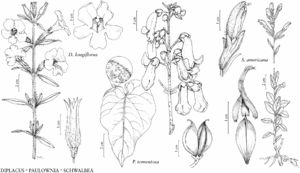Paulownia tomentosa
Nomencl. Bot. ed. 2, 2: 278. 1841.
Stems to 20 m; crown spreading; bark grayish brown, thin, slightly fissured; twigs usually viscid when young, pith hollow or chambered, lenticels conspicuous, white. Leaves usually largest on sprouts, smallest near inflorescences; petiole (1.5–)5–21(–36) cm, floccose or sparsely to densely lanate, rarely glabrate; blade ovate to broadly ovate, (6–)14–40(–50) x (4–)8–30(–56) cm, base cordate, sometimes truncate, apex acute, acuminate, or cuspidate, floccose or sparsely to densely lanate abaxially, sometimes only along veins, glabrate or sparsely lanate adaxially. Thyrses 18–40 cm; verticillasters 6–10, interrupted, conical, axis glabrous or sparsely lanate; peduncle ascending, 0–5 cm, glabrous or sparsely to densely lanate. Pedicels 0.8–1.5 cm, brownish lanate, jointed at apex with flower. Flowers pendent, fragrant; calyx tube 6–9 mm, brownish lanate, lobes 7–9 x 5–8 mm, leathery, brownish lanate, margins entire, apex obtuse to acute; corolla 4–6 cm, glandular-pubescent externally, glabrous internally, tube 1–1.5 cm, slightly downcurved, throat gradually inflated, 1.5–2 cm diam., palate 2-ridged, abaxial lobes projecting-spreading, adaxial reflexed; stamens included; pollen sacs opposite, white, tan, or brown, flattened, 1.8–2.3 mm, dehiscing across connective, glabrous; styles 24–30 mm, sparsely hairy proximally. Capsules persistent, ovoid, 2.5–5 x 1.5–2.6 cm, cartilaginous, viscid, floccose distally. Seeds fusiform, 3–4 mm, surrounded by prominent wings, margins irregular, wings reticulate. 2n = 40.
Phenology: Flowering Apr–Jun.
Habitat: Roadsides, riparian areas, forest margins, old homesteads, strip mines, soil banks, clearcuts.
Elevation: 0–1200 m.
Distribution
Ala., Ark., Conn., Del., D.C., Fla., Ga., Ill., Ind., Ky., La., Md., Mass., Miss., Mo., N.J., N.Y., N.C., Ohio, Okla., Oreg., Pa., R.I., S.C., Tenn., Tex., Va., Wash., W.Va., Asia (China), introduced also in Europe, elsewhere in e Asia (Japan, Korea).
Discussion
Paulownia tomentosa was brought to the United States around 1844 from plants introduced into cultivation in Europe (Hu S. Y. 1961); it has been planted as an ornamental and shade tree in southern Canada, eastern and northwestern United States, Europe, Japan, and Korea. Trees are fast-growing and produce sturdy, light wood. Princess-tree is a prolific seed producer, resprouts from suckers when cut, and can become an aggressive invader in disturbed habitats. In North America, it shows a tendency to invade natural habitats more frequently than do plants in central Europe (E. Franz 2007); it is increasingly invading natural forests in the southern Appalachian Mountains. Paulownia tomentosa was designated in 2004 as an exotic with a severe threat to escape in Tennessee (Tennessee Exotic Pest Plant Council 2004); it is prohibited in the nursery trade in Connecticut (Connecticut Invasive Plants Council, http://cipwg.uconn.edu/invasive_plant_list/). The broad wings of the seeds aid in wind dissemination and apparently facilitate imbibition (R. Vujičić et al. 1993). A count of 2000 seeds per capsule, which appears widely in the literature, apparently came from R. S. Walker (1919).
The type and abundance of hairs of Paulownia tomentosa varies greatly with phenology and location on plants. Dendritic hairs occur on leaves and in inflorescences; they are dense on pedicels and calyces. Their abundance on leaves varies, and there they may occur mixed with eglandular or glandular, erect, unbranched, multicellular hairs. Leaf vestiture has been used to distinguish two varieties: var. tomentosa, with leaf blades densely lanate abaxially, and var. tsinlingensis (Pai) Gong Tong, with leaf blades glabrous or sparsely lanate abaxially when young (Hong D. Y. et al. 1998). The validity of these varieties cannot be evaluated from North American material alone.
Selected References
None.
